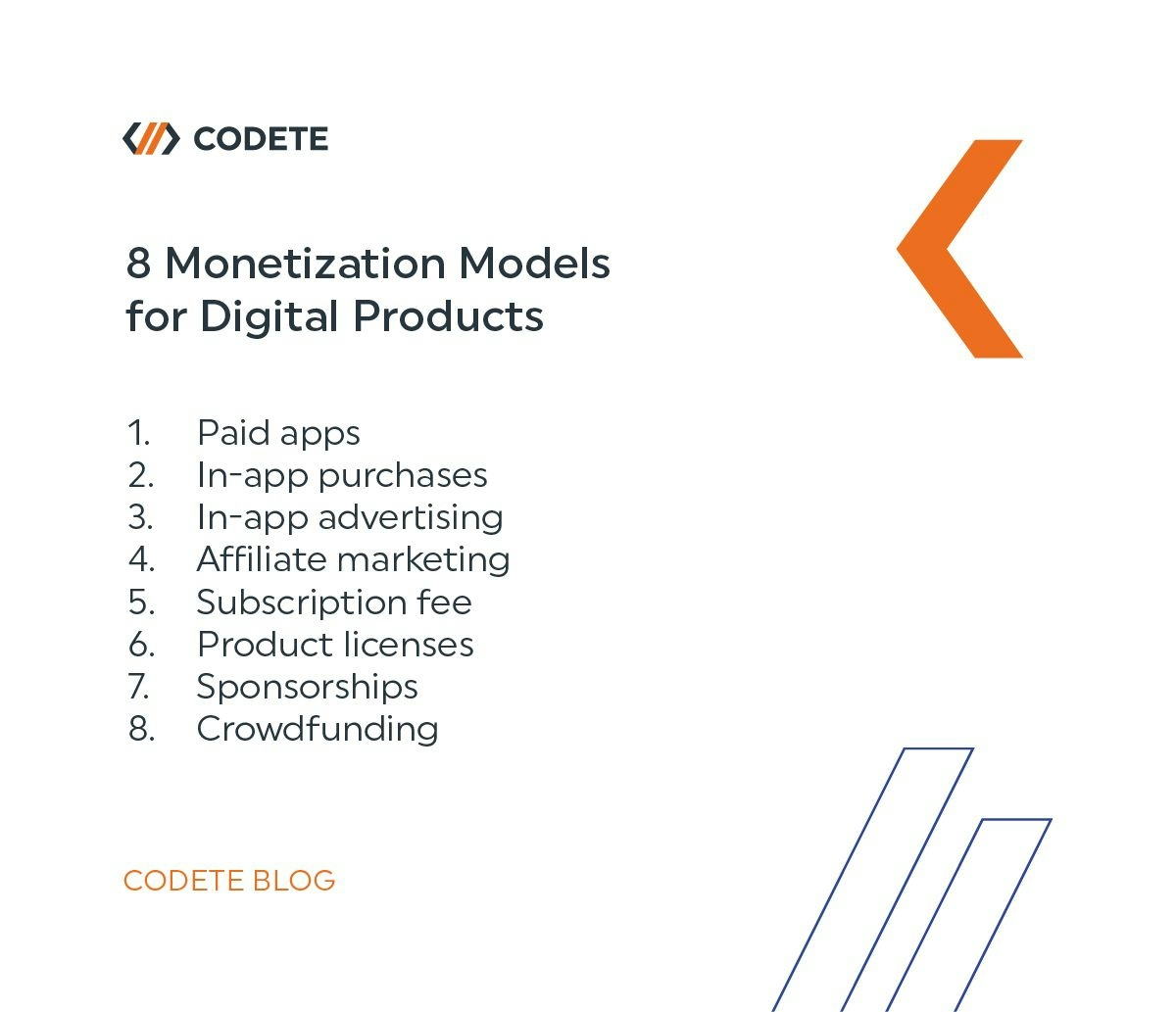Building a digital product takes a lot of time, energy, and money. No wonder that you want to make sure that it brings you a good return on investment.
That's why you need to come up with your mobile app monetization strategy. It's basically about choosing how your application is going to make money. Don't leave this step for when your product is ready – instead, plan it right from the start.
What are the most popular methods for monetizing a digital product today? Which ones bring the greatest ROI? Keep on reading this article to learn everything you need to know about digital product monetization today.
Table of contents:
- Digital product monetization – here's what you need to know
- 8 most popular monetization models
- What's your preferred product monetization strategy?
Digital product monetization – here's what you need to know
A product monetization strategy outlines how you're going to generate revenue from your digital product. App monetization strategies range from selling ad placements to launching sponsored content and offering paid membership subscriptions.
For example, if you build a mobile application where users can see how to get from point A to B, you can monetize it by selling ads to ridesharing apps like Uber inside your app. Or you can enable in-app purchases meaning that users can download the product and use its core features for free, but pay for premium features.
By coming up with an app monetization strategy early on in product development, you will make sure that your product generates revenue as soon as you launch it and build traction.
How to pick the right monetization tactic for your product?
First of all, you need to learn more about your audience. What are their preferences and behaviors? How much are your future users willing to pay for an app? Are they willing to pay for it at all? Will they tolerate an application with personalized ads?
The monetization method you pick needs to fit really well with the entire user experience and flow in your application. Deciding on that early on will help you to smoothly align monetization into the product's functionality and user flow – and make sure it all matches your business model and value proposition.
8 most popular monetization models
1. Paid apps
In the past, when mobile app stores were just being launched, users often had to pay for mobile apps. This was the dominant app monetization model companies used back then. It's hard to believe that, right? In-app purchases and ads entered the scene only later on.
Today, there are several categories of digital products for which the paid apps model still works really well:
- productivity apps,
- photo and video editing apps,
- navigation apps,
- utility apps.
Users can also buy several apps at the same time – this is called an app bundle. The iOS App Store App Bundle concept allows iOS app users to buy and download a number of related apps from the same app developers at once. With this model, you get paid every time an app is bought separately or as part of a bundle.
2. In-app purchases
One of the easiest ways for an application to bring you revenue is by charging users for extra features or purchases they can make once they start using it.
A study by Gartner (quoted by Business Insider) shows that consumers prefer to spend money on in-app purchases more than paying for an app upfront in the store. And in general, iOS users tend to spend more on apps than Android users. So, if you're building an app for iOS users, you can be confident that buying options inside your mobile app won't make them turn away.
In-app purchases can unlock extra premium features to your users but leave the core product free of charge (this is related to the freemium model). That way, you can build deeper engagement with your audience and inspire customers to buy extra functionalities once they already know the value they get from your digital product.
3. In-app advertising
Another common type of monetization approach is offering ad placements inside your digital product. Mobile app advertising is a powerful trend today and many applications use this tactic.
But if you pick it – be extra careful about the ad format. It's important that the size, type, and placement of the banner ads are all carefully planned. You need to make sure that your product still delivers a great user experience and the ads don't end up annoying more than a few users.
Also, pick in-app ads that are relevant to your target audience. Always promote high-quality products to boost retention and avoid losing user engagement.
4. Affiliate marketing
Affiliate marketing is an interesting monetization tactic for a mobile app. In the context of mobile apps, affiliate marketing means that you are rewarded with a commission fee for every time the user downloads the app or takes a specific action using a link placed inside your application.
Naturally, the kind of apps you will promote inside your digital product is important. Make your choice carefully – these apps should complement your own product and add value to the user experience.
An alternative approach to this is capturing the contact information of people who are explicitly interested in purchasing specific products or services. In this type of affiliate marketing program, you're paid for supplying this information to the company looking for such leads.
5. Subscription fee
The subscription model is very common among many types of digital products such as mobile applications, games, and Software as a Service (SaaS).
To make it work to your advantage, you have to include some kind of paywall or introduce a free trial period. You can also go for a metered paywall that appears after a given level of content use is reached. That’s a solution commonly used by the press. For example, many magazines only share a bit of their most valuable articles for free. You have to buy a subscription to read the whole thing – and access more interesting content.
Depending on how many features your product offers, you can create different subscription plans. That way, you can generate more revenue instead of simply shutting your visitors out.
6. Product licenses
Licensing digital products can be done in many different ways.
On the one hand, subscription-based streaming services like Netflix or Spotify buy licensed content (such as film or music) from other companies. On the other hand, Shazam – the audio recognition technology – is often licensed to other companies to increase its revenue stream. Naturally, you can also license your proprietary technology to others. For example, data as a product or API as a product are both good ways to monetize digital products that work with data, features, and APIs.
7. Sponsorships
This type of advertising might not be that obvious for people who are building digital products. If your application has a large user base and a high level of user engagement, why not offer the services of another company to your audience?
By using the sponsorship model, you engage in an advertising relationship with a single advertiser. A sponsor can be present with just an icon or cover a larger portion of your app's interface. You can also use the app splash screen for this purpose – it's a screen visible to abusers right after the application launch. Even push notifications are an option.
When choosing your ads, pick ones that don't disrupt the user flow or functionality of your application.
8. Crowdfunding
Crowdfunding platforms like IndieGogo, Kickstarter, and GoFundMe are popular channels for monetizing digital products.
But before jumping in, note that they're unpredictable in terms of the generated revenue. You also have no guarantees about the stability of your revenue stream. This channel is a great option for side revenue. Using it as a major income source is not a good idea.
If you want to know whether crowdfunding offers an opportunity for your type of digital product, take a look at the most popular crowdfunding platforms in your area and check whether similar applications achieved success there.
What's your preferred product monetization strategy?
Choosing your app monetization model early on in the product development process allows you to build a strong foundation for generating app revenue as soon as possible and get new sources of income, such as advertisers.
We hope that the list of strategies above inspires you to reach out for alternative approaches that set you apart and help you build a competitive advantage.
And if you're looking for business analyst support here, get in touch with us. We know what it takes for a product to start generating serious revenue – and how to build it right!


